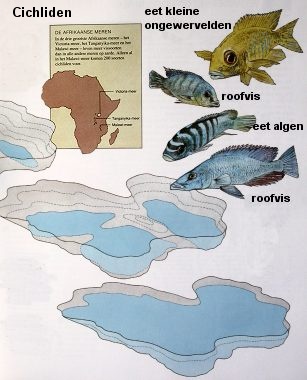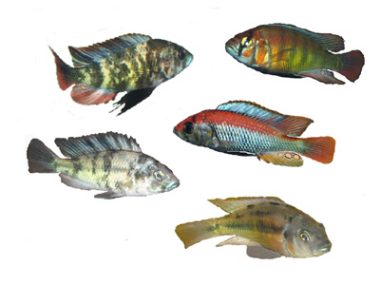
After Whitfield: De evolutie van het leven
(1994)
When a female fish lays her eggs (emit spawn), hordes of other fishes are waiting for their chance to eat these eggs. For many fishes there is only one place where the eggs can hatch safely: in the mouth. As soon as the female has laid her eggs, she takes them into her mouth and keeps them there until they are hatched out. Such fishes are called: mouth breeders. Problem for the fishes is that the eggs are taken in the mouth so quickly that there is no time for fertilization. To solve this the following adaptation has evolved. In the male fishes of the species so-called egg spots have developed on the anus fin. These are shown to the females while they are snapping to the eggs. The female snaps to the egg spot and at that moment the male loosens his sperm so that the eggs are fertilized in the mouth of the female.
Many more of such examples are described in the wonderful book by Tijs Goldschmidt: Darwin's Dreampond. However, he also describes how many species got extinct after the introduction of the Nile perch in Lake Victoria. The purpose of this introduction was to give the people a source of food, but it turned out disastrous for the cichlids.
Know more?
Cichlids
from Lake Victoria
Lake
Victoria
After the introduction of the Nile perch in Lake Victoria many species went extinct. Moreover, the growth of algae has increased with the consequence that the water became less clear. That's why colours have become a less important factor in the evolution and the species tend to become less colourful.
Another interesting example: There are species obtaining their food by nibbling the scales of other fishes: they are called scale-eaters. Inside this group two species have evolved: the left-handed scale-eaters and the right-handed scale-eaters. The first group bends the head to the left-hand side while nibbling, the second one to the right-hand side.
Know more?
Cichlids
